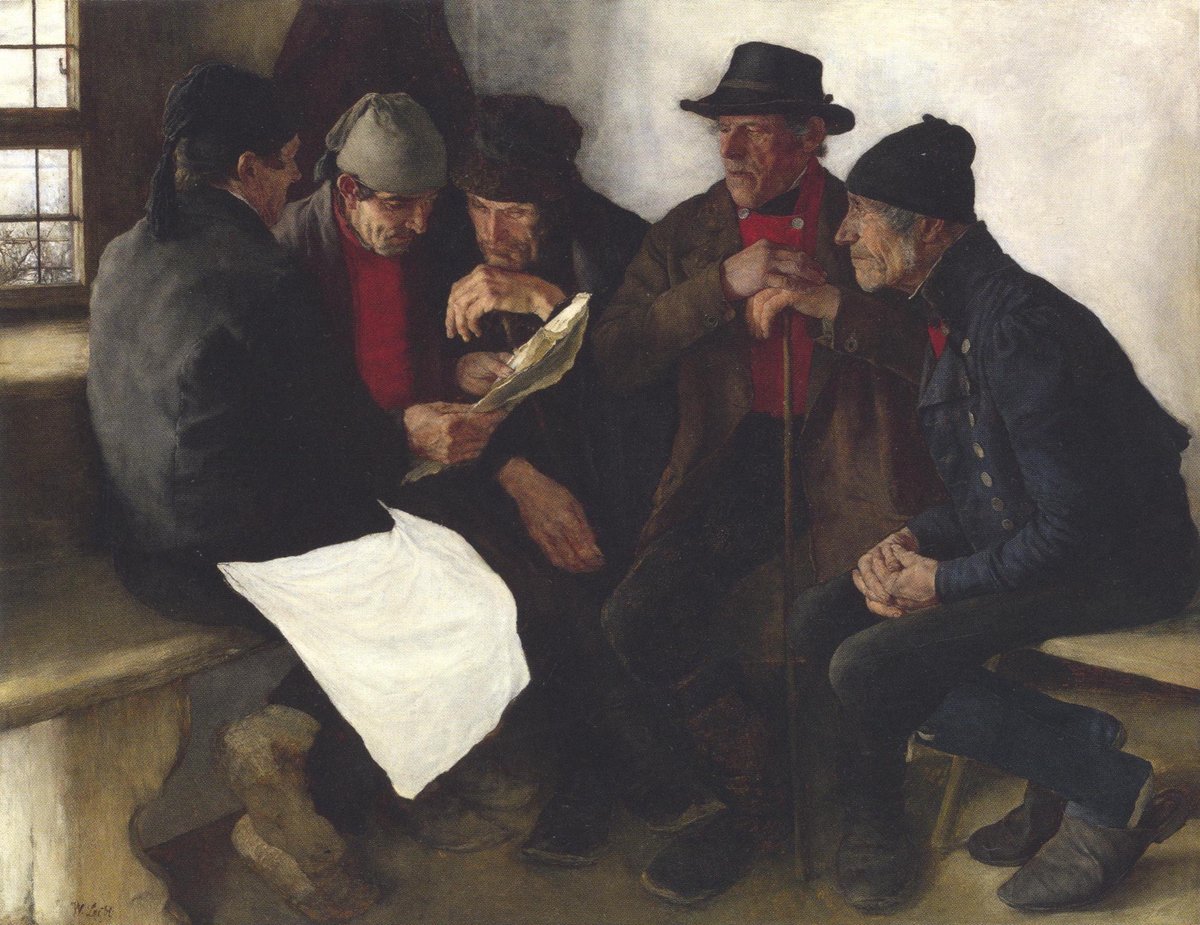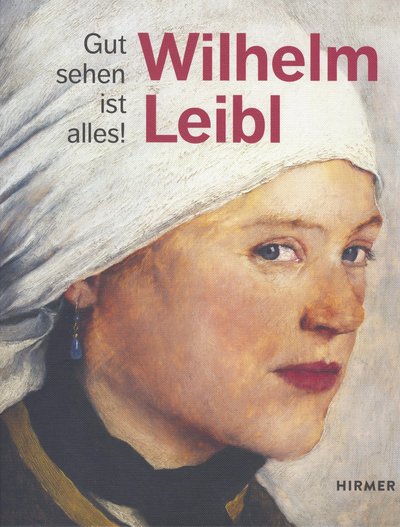“Paint the man, as he is, then the soul will most certainly be there”
On the exhibition of Wilhelm Leibl’s works at the Kunsthaus Zürich
by Urs Knoblauch, cultural journalist, Fruthwilen
The Kunsthaus Zürich is showing the first Swiss retrospective of the painter Wilhelm Leibl’s work (1844–1900). The exhibition’s leitmotif is “Seeing well is everything”. It addresses the search for and representation of “natural truth”, the central concern of 19th-century realism. The artist, born in Cologne is regarded as one of the most important representatives of this concept of art, which was at that time emerging throughout Europe, and of the artists’ associations devoted to it. The development of modern life in the metropolis also brought about a new appreciation of the rural world and people. In this context, in particular Leibl’s relatively small work represents a great treasure. The artist died at the age of only 56. He found recognition already early in life. He participated in numerous international exhibitions and his true-to-life portraits and human portrayals found their way into public collections at high prices. Wilhelm Leibl’s great contribution was to really capture the “truth of nature”, the spiritual dimension and the sensitive emotions of man in his magnificent portraits and figure paintings. The present exhibition will surely cause the painter to be rediscovered. The Kunsthaus director Christoph Becker developed the idea with curator Bernhard von Waldkirch ten years ago, and it has now been successfully realised with the cooperation of Marianne von Manstein. The exhibition focuses on portraits, on interiors with figure paintings of the artist’s circle of friends, and on people from rural areas. The 40 paintings and 60 drawings are excellently presented and can be admired thematically in six collection rooms in the stylish ambience of Karl Moser’s museum, which was built at the beginning of the 20th century. Thus the exhibition also appears as a wonderful synthesis of the arts, together with related works in the other rooms of the museum. Accompanying texts on the works and an excellent catalogue make the visit a valuable art experience.

arly mastery, stimulating art studies, role models and first successes
Wilhelm Maria Hubertus Leibl was born in Cologne in 1844, as the fifth of six children of the director of music Karl Leibl and his wife Gertrud (née Lemper). Already as a pupil his interest in and talent for drawing became evident. After an abandoned apprenticeship as a locksmith, a Cologne artist gave him his first drawing and painting lessons. His parents were interested in the fine arts, and their influence became apparent at an early age. The son often accompanied his father to church, where the special atmosphere and the music became formative impressions. From 1861 on he had the chance to consolidate his artistic education with the help of the history painter and art critic Hermann Becker. He created the first remarkable portraits of his family and relatives. In 1863, Wilhelm Leibl was admitted to the prestigious Academy of Fine Arts in Munich and began to study classical art. In a letter to his parents he wrote: “There is not really much to say about my occupation, which consists of going to the academy every day at 8 o’clock in the morning and drawing heads and figures in plaster there and in the antiquity hall; it is not allowed to work in the painting class at the same time, and I believe that drawing is even more useful to me for now [...]. We hear lectures on art history, perspective and anatomy in the evenings. Every evening from 5 a.m. to 7 a.m. we practice nude drawing.” (Catalogue, p. 114) He gained an important foundation for his art by painting and studying the great painters (Rembrandt, Rubens, Hals, Holbein, van Dyck, and Velasquez) in the Alte Pinakothek in Munich. The industrious art student already became known for some of his special pieces when he was still a student of the academy in Munich. He made friends with his fellow students (Johann Sperl, Theodor Alt and others), and formed a regular circle of friends with discussions at a Munich inn. As a master student, he came into contact with modern French art through his professor. As early as 1869, the young artist was able to exhibit four of his pieces at the 1st International Art Exhibition in the Glaspalast in Munich. He was impressed by the works of his contemporary painters and realists Gustave Courbet and Jean-Francois Millet.

When Courbet visited the exhibition in Munich, he was enthusiastic about the young Leibl and invited him to Paris, where he was able to work in a studio. He met the artists of realism and the emerging “open-air painting” of the “Barbizon painters”. In 1870 he was invited to the famous Paris “Salon Exhibition” and received his first gold medal for his “Portrait of Mrs. Gedon” exhibited there. Because of the outbreak of the war of 1870/71, the painter had to return to Germany.
In the following years, the artist was in the happy position of taking part in numerous exhibitions and carrying out commissions. The artist Johann Sperl was a lifelong close friend. A tragic love affair and a child dying in infancy were a heavy blow of fate.
Close to the human being: search for “natural truth” and tangible country life
The emerging industrialisation and rapid urbanisation prompted the passionate painter and hunter and his artist friends from the “Leibl circle” to move to the countryside after 1873. There they found the natural models, people whom Leibl portrayed in great “natural truth” and with great mastery, down to the finest mental forms of expression. The particularly beautiful work “Leibl und Sperl auf der Jagd” (Leibl and Sperl hunting - around 1888) shows the friendly relations between the two painters: the figures were painted by Leibl and the landscape by Sperl, so as to result in a joint painting.
The present exhibition shows particularly impressive drawings, portraits and figure paintings, which are always depicted in human and spatial terms as well as in the atmospheric play of light and dark. The basis for this “true vision” is his natural bonding to man as well as his meticulous and patient observation of his models, which usually lasted through numerous sessions, exhausting for him and for the models.
In a letter to an art historian he wrote: “Paint the man, as he is, then the soul will most certainly be there”. (p. 154) With this statement he addresses the psychological dimension, the state of mind, the interpersonal emotional feeling, the interplay of the inner emotional life of the artist and the model, which is reflected in the facial expression, the gestures and the posture.
Leibls mastery can be seen in the subtleties, in the eye contact of the models with the observer, as they are portrayed in reflection or while concentrating on an occupation in domestic life. The pictures reflect the manifold living environments as well as their respective truths of life and cause an intensive interpersonal transfer of feelings. In the Hamburg Kunsthalle we can see the famous work “Three Women at Church”, which touched van Gogh deeply. At the exhibition In Zurich we may admire an equally important work, the large-format oil painting “Die Dorfpolitiker” (The village politicians, 1877), on loan from the Kunstmuseum and the Oskar Reinhart Foundation, (see illustration). Leibl’s concern to paint both the outer and inner life of man according to “true vision” is expressed particularly impressively here. The picture shows five men in consultation. Together, they are looking for a solution to a smaller or larger problem by weighing the pros and cons. On 3 June 1876, the artist describes the scene in a letter to his mother, with whom he was in constant contact, “well, my picture shows five farmers putting their heads together in a small farmhouse room, presumably because of a communal matter, because one of them is holding a paper in his hand that looks like an old land register. But they are real farmers, because I paint them all as faithfully as possible and after nature; also is the farmhouse parlour really such a one, as I am painting the picture in the same, you can even see a piece of the Ammersee out of the window “. (p. 162) Leibl lays emphasis on the fact that they are “real farmers”. With this humanly touching scene he leads the viewer into an ethical-political dimension, into the everyday world of today and shows us a possible way to a peaceful cooperation in the sense of the common good. Bernhard von Waldkirch refers to a statement by the art historian Eberhard Ruhmer, who emphasises that for Leibl art is “primarily an ethical task”, because “its object is truth” (p. 36). Wilhelm Leibl’s works and the exhibition refer to numerous artists. There are particular points of contact with the paintings of the great Swiss painter Albert Anker, whose realism highlighted the social-ethical dimension in a particularly impressive way.
Throughout history, art has repeatedly been criminally abused or devalued by untruths and prejudices. Thus the National Socialists also attempted to instrumentalise several of the artist Leibl’s motifs for their criminal folk ideology. This exhibition also makes a meritorious contribution to a true, objective, just and cultural debate and to social-ethical achievement. This is entirely in line with Leibl’s concern: “I only wish that the endeavours at natural truth and true artistic calling, which I make while painting, will be transplanted to future generations”. •
The exhibition will be open until 19 January 2020. Information on accompanying events can be found at Kunsthaus Zürich: 41 (0) 44 253 84 84 or
www.kunsthaus.ch